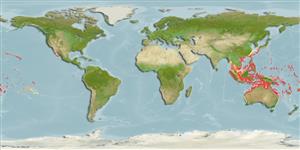Environment: milieu / climate zone / depth range / distribution range
Écologie
marin récifal; profondeur 1 - 60 m (Ref. 1602). Tropical; 35°N - 35°S, 95°E - 125°W (Ref. 47838)
Indo-Pacific: East Africa (south to Port Alfred, South Africa, Ref. 5372) to the Hawaiian, Marquesan, and Ducie islands, north to southern Japan, south to the Lord Howe and Rapa islands; throughout Micronesia.
Taille / Poids / Âge
Maturity: Lm ? range ? - ? cm
Max length : 20.0 cm TL mâle / non sexé; (Ref. 9710); common length : 16.0 cm TL mâle / non sexé; (Ref. 48636)
Épines dorsales (Total) : 12 - 13; Rayons mous dorsaux (Total) : 19 - 23; Épines anales: 3; Rayons mous anaux: 18 - 20.
Occur in small groups in reef flats, clear lagoon and seaward reefs (Ref. 48636). Benthopelagic (Ref. 58302). Feed on soft and hard corals, also on polychaetes, small crustaceans, and filamentous algae. In Indonesia, usually seen at moderate depths, usually swimming in small groups. Adults are mainly in depth 20-60 m (Ref. 48636). Oviparous (Ref. 205), monogamous (Ref. 52884). Form pairs during breeding (Ref. 205).
Life cycle and mating behavior
Maturities | Reproduction | Spawnings | Egg(s) | Fecundities | Larves
Distinct pairing (Ref. 205). Monogamous mating is observed as both obligate and social (Ref. 52884).
Myers, R.F., 1991. Micronesian reef fishes. Second Ed. Coral Graphics, Barrigada, Guam. 298 p. (Ref. 1602)
Statut dans la liste rouge de l'IUCN (Ref. 130435)
Menace pour l'homme
Harmless
Utilisations par l'homme
Pêcheries: intérêt commercial mineur; Aquarium: Commercial
Outils
Articles particuliers
Télécharger en XML
Sources Internet
Estimates based on models
Preferred temperature (Ref.
123201): 24.3 - 28.8, mean 27.6 °C (based on 518 cells).
Phylogenetic diversity index (Ref.
82804): PD
50 = 0.5000 [Uniqueness, from 0.5 = low to 2.0 = high].
Bayesian length-weight: a=0.02818 (0.01692 - 0.04693), b=3.00 (2.86 - 3.14), in cm total length, based on LWR estimates for this species & Genus-body shape (Ref.
93245).
Niveau trophique (Ref.
69278): 3.3 ±0.3 se; based on diet studies.
Résilience (Ref.
120179): Haut, temps minimum de doublement de population inférieur à 15 mois (Preliminary K or Fecundity.).
Fishing Vulnerability (Ref.
59153): Low vulnerability (10 of 100).
Nutrients (Ref.
124155): Calcium = 85.1 [45.0, 130.0] mg/100g; Iron = 0.753 [0.453, 1.216] mg/100g; Protein = 18.6 [17.5, 19.7] %; Omega3 = 0.122 [0.077, 0.193] g/100g; Selenium = 36.2 [20.8, 66.5] μg/100g; VitaminA = 48.7 [14.5, 161.6] μg/100g; Zinc = 1.3 [0.9, 1.8] mg/100g (wet weight);
